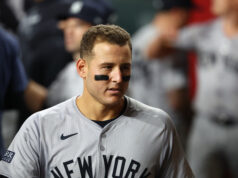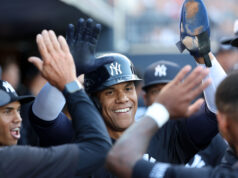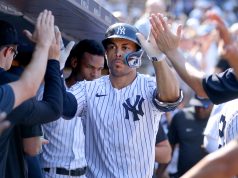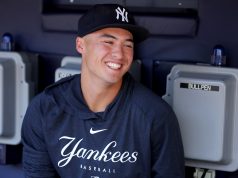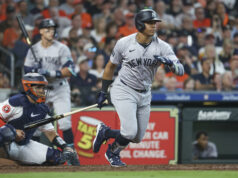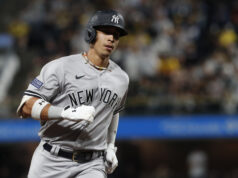Aaron Hicks began the year as an expendable fourth outfielder. He’s since become a key to the New York Yankees success.
The New York Yankees looked destined for a second straight loss Friday night. Heading into the bottom of the eighth inning, they trailed division-leading Boston, 3-0. But things suddenly turned in their favor.
After Brett Gardner was hit by a pitch, Aaron Hicks stepped to the plate, In just his ninth plate appearance since his activation from the disabled list, Hicks left his mark on the Yankees-Red Sox rivalry.
Batting from the left side, Hicks belted a 1-2 slider from Addison Reed over the right field wall for a two-run home run. The fans were finally on their feet in the Bronx. Reed, seemingly, had inadvertently had awoken a sleeping giant in the Yankees offense.
Aaron Hicks. Clutch home run. Emotion. Exactly what #Yankees need pic.twitter.com/fLETN7sAq8
— Dan Federico (@RealDanFederico) August 12, 2017
The home run started a chain of events for the Yankees. Reed failed to record an out before being forced out of the ballgame. Singles by Didi Gregorius and Todd Frazier, as well as a sacrifice fly from Ronald Torreyes, helped the Yankees take a 5-3 lead heading into the ninth inning.
Aroldis Chapman wasn’t sharp, walking three consecutive batters to start off the top of the ninth inning. Lo-and-behold, it was Hicks’ time to shine once again.
Andrew Benintendi hit a soaring fly ball to deep left field. As Hicks settled under it, former Yankee Eduardo Nunez tried to test his arm and swipe third base. Hicks had other plans, unleashing a rocket to nail Nunez at third, with help from a nice pick by Todd Frazier.
BIG 2-run HR in the 8th.
Clutch defensive play in the 9th.
It's good to have ya back, @AaronHicks31! ?? pic.twitter.com/W517AodZcY
— New York Yankees (@Yankees) August 12, 2017
The Yanks went on to win, 5-4.
Yankees fans were suddenly falling back in love with “A-A-Ron” after missing him for over a month.
Things were not always this nice for the 27-year-old outfielder from San Pedro, California.
Hicks was a 23-year-old rookie with the Minnesota Twins in 2013. He failed to meet modest expectations in his first two seasons, hitting .201/.293/.313 with an OPS+ of 69 over in 150 games.
In 2015 he became more of a regular in the Twins outfield, appearing in 97 games. Across 390 plate appearances, he slashed .256/.323/.398 with an OPS+ of 98. Toss in 25 extra-base hits (11 HR), 33 RBI and 13 stolen bases, and he had a solid season.
That winter, Hicks was traded to the Yankees for backup catcher John Ryan Murphy.
Hicks started really slow out of the gate in the Bronx. He posted a .247 OPS his first month with the Yankees, picking up a mere two hits in 23 at-bats. He might have struggled at the plate, but he didn’t struggle to make the highlight reels with his rocket arm.
Hicks played more in May (28 games) and his numbers improved. He slashed .222/.290/.346 with six extra-base hits (two home runs) and nine RBI. But he struggled again in June and July, slashing a combined .181/.239/.286 over 42 games.
That maddening inconsistency was part of Minnesota’s reasoning for trading him. But Yankees manager Joe Girardi kept playing him in spite of it all. Once the Yankees traded away Carlos Beltran, Hicks saw his playing time increase once again.
Right after the deadline, general manager Brian Cashman compared Hicks to Red Sox outfielder Jackie Bradley Jr. Like Hicks, Bradley struggled early in his career before delivering a breakout All-Star campaign in 2016.
“[Hicks] hasn’t played out to the level that I expected at all,” Cashman told reporters, per Chad Jennings, formerly of LoHud.com. “That doesn’t mean that he can’t and won’t break out. He’s in a situation where I would caution everybody to look at what Jackie Bradley Jr. did two years ago and then last year as an everyday guy struggling to make it through and get his feet on the ground and get his sea legs under him.”
Girardi added that Hicks was “going to play a lot” from that point on. And with more playing time came better results. Sitting below the Mendoza line (.187 BA) heading into August, he began to really turn things around in pinstripes.
Hicks delivered a .280/.330/.429 August slash line with five extra-base hits (four home runs) and nine RBI—his best month of the season. He would miss most of the first three weeks of September with a hamstring injury and finished the year with a .217/.281/.336 slash line.
This spring, Hicks was not only fighting for the starting job in right field but a spot on the 25-man roster. Despite a strong spring, Aaron Judge beat him out for the starting spot and he began the year as the team’s fourth outfielder.
But Hicks looked like a more comfortable, confident player. He hit .290 with 25 extra-base hits (10 HR), 37 RBI and nearly as many walks (37) as strikeouts (42) in the season’s first half.
While he was sidelined by an oblique injury on June 25, the Yankees still pushed for his inclusion in the All-Star Game. “Hicks has shown the league enough that he could be an All-Star,’’ Cashman remarked to the New York Post‘s George A. King III.
Girardi credited Hicks for being mature enough to recognize that things needed to change.
“I think you have seen players mature at different times in their careers, and part of it is that he made some adjustments to his swing in the offseason,’’ Girardi told King of Hicks, who shortened his swing. “He knew he had to make adjustments.”
Hicks missed 39 games with the oblique injury, and the Yankees struggled to play .500 ball without him, going 19-20. They dropped from first place in the AL East to more than four games behind Boston in the division.
After going hitless in his first game back in Toronto on Thursday, Hicks picked up two hits Friday night at home, including the two-run bomb off Reed. He’s starting to get back into a groove.
A switch-hitter, Hicks mostly faced left-handed pitching last season. This year, he has prospered against both lefties and righties. While the Yankees have a crowded outfield, Hicks has proven that he deserves to play on a daily basis.
If the Yankees are going to advance to the postseason, Hicks is going to play a big part in getting them there.



